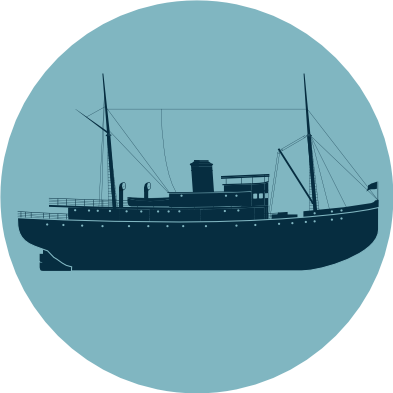
 0
0How does this icebreaker move?
Engines
You are now standing between the ERNEST LAPOINTE’s two engines.
They are powered by steam from the boiler room.
-lb86mpq.gif?alt=media&token=0bca152d-6085-4038-ad03-2a15b2bbc494)
Are you wondering about the sound that this engine used to make?
Listen to a steam engine like the ones on the ERNEST LAPOINTE.
Boiler pressure gauges

The pressure gauges indicate the boilers’ pressure level.
Engine order telegraph

Here are the engine order telegraphs that are in contact with those in the wheelhouse.
Steam supply valve

This valve controls the pressure of the steam entering the piston chambers.
For example, if the engine has to go faster, more steam must enter.
Would you like to see a steam engine in action?
Pressure gauges of the piston chambers

These pressure gauges indicate the amount of steam in the piston chambers.
Engine reverse lever

Tilting this lever reverses the rotational direction of the ship’s engine and propellers, making the ship move backward.
But what would happen if the two engines turned in opposite directions?
Yes! The ship would turn around!

Drip-feed oiler

These tubes show the speed at which oil drips to adjust its flow.
Oil flows through a specific pipe connecting the oiler to the engine to lubricate each of its parts.
Connecting rod and crankshaft

Pistons move up and down, but propellers rotate.
The connecting rod and crankshaft are components that work together to convert the straight-line movement of a piston into a rotational movement.
-j6up0od.gif?alt=media&token=f7925346-731f-44ee-a61a-64dc0f877e92)
Propeller shafts

The propeller shafts connected to the crankshaft run the entire length of the ship to its stern and transfer the engine’s rotational movement to the propellers.

Do you remember what the stern is?
Yes! The back of the ship!
Condensers

Condensers are located behind the engines. These cylinders contain coils that condense steam into water before it returns into the boilers.
Water is constantly pumped into the condensers to cool them down.
Supply tank

Water flowing from the condensers is forced into this tank, then transferred back into the boilers.
Guillotine door

This door can be closed in case of emergency to prevent water from flooding the compartment.

